Gigabyte G1.Assassin (rev. 1.0) User Manual [ru]

G1.Assassin
LGA1366 socket motherboard for Intel® Core™ i7 processor family
User's Manual
Rev. 1002
12ME-G1ASSAS-1002R
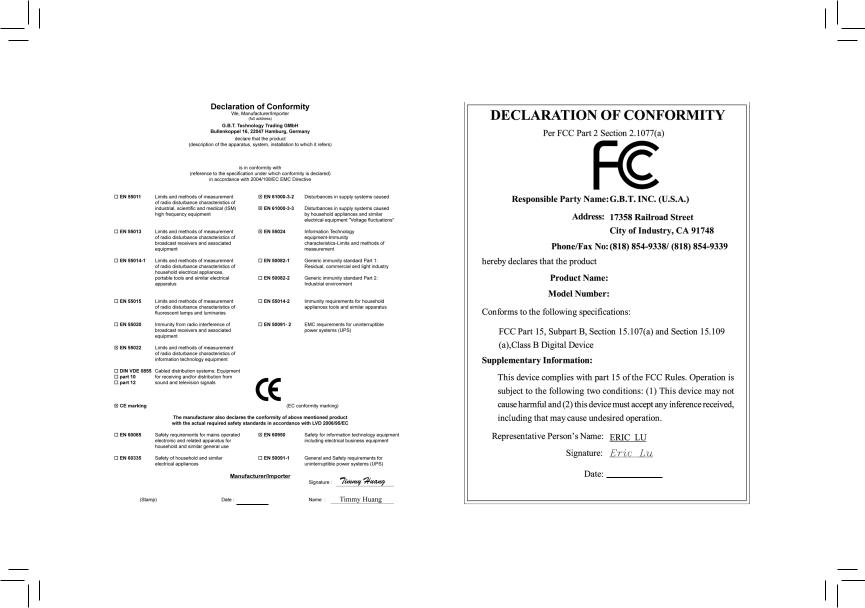
Motherboard
G1.Assassin
Motherboard
G1.Assassin
Jan. 12, 2011
Jan. 12, 2011
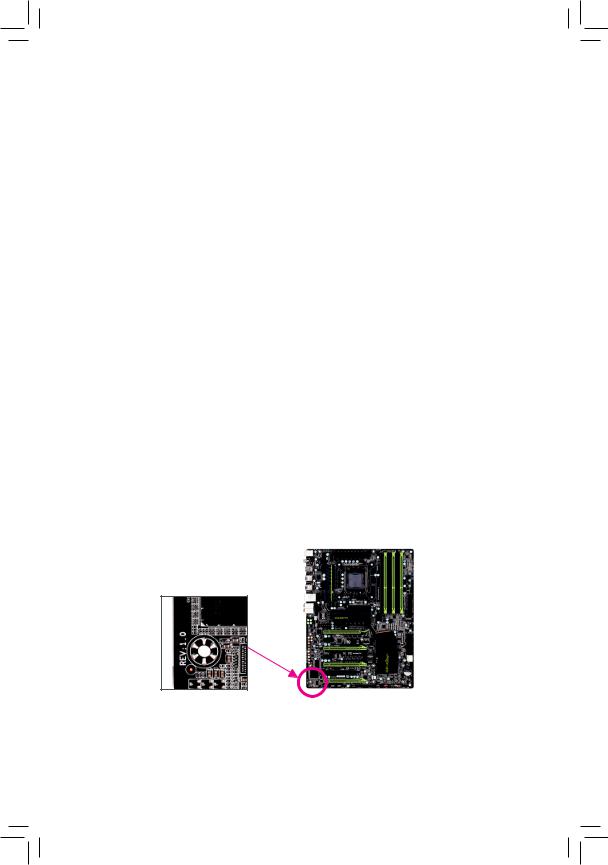
Copyright
© 2011 GIGA-BYTE TECHNOLOGY CO., LTD. All rights reserved.
The trademarks mentioned in this manual are legally registered to their respective owners.
Disclaimer
Information in this manual is protected by copyright laws and is the property of GIGABYTE. Changes to the specifications and features in this manual may be made by GIGABYTE without prior notice. No part of this manual may be reproduced, copied, translated, transmitted, or published in any form or by any means without GIGABYTE's prior written permission.
Documentation Classifications
In order to assist in the use of this product, GIGABYTE provides the following types of documentations:
For quick set-up of the product, read the Quick Installation Guide included with the product.
For detailed product information, carefully read the User's Manual.
For product-related information, check on our website at:
http://www.gigabyte.com
Identifying Your Motherboard Revision
The revision number on your motherboard looks like this: "REV: X.X." For example, "REV: 1.0" means the revision of the motherboard is 1.0. Check your motherboard revision before updating motherboard BIOS, drivers, or when looking for technical information.
Example:

Table of Contents
Box Contents.................................................................................................................... |
|
|
6 |
Optional Items.................................................................................................................. |
|
|
6 |
G1.Assassin Motherboard Layout.................................................................................... |
7 |
||
G1.Assassin Motherboard Block Diagram....................................................................... |
8 |
||
Chapter 1 Hardware Installation...................................................................................... |
9 |
||
1-1 |
Installation Precautions..................................................................................... |
9 |
|
1-2 |
Product Specifications.................................................................................... |
10 |
|
1-3 |
Installing the CPU and CPU Cooler................................................................ |
13 |
|
1-3-1 |
Installing the CPU................................................................................................... |
13 |
|
1-3-2 Installing the CPU Cooler........................................................................................ |
15 |
||
1-4 |
Installing the Memory...................................................................................... |
16 |
|
1-4-1 Dual/3 Channel Memory Configuration................................................................... |
16 |
||
1-4-2 |
Installing a Memory ................................................................................................ |
17 |
|
1-5 |
Installing an Expansion Card.......................................................................... |
18 |
|
1-6 |
Setup of ATI CrossFireX™/NVIDIA SLI Configuration...................................... |
19 |
|
1-7 |
Installing the 5.25" Front Access Control Panel ............................................. |
21 |
|
1-8 |
Back Panel Connectors.................................................................................. |
22 |
|
1-9 |
Onboard LEDs................................................................................................ |
24 |
|
1-10 |
Internal Connectors........................................................................................ |
27 |
|
Chapter 2 BIOS Setup................................................................................................... |
37 |
||
2-1 |
Startup Screen................................................................................................ |
38 |
|
2-2 |
The Main Menu............................................................................................... |
39 |
|
2-3 |
MB Intelligent Tweaker(M.I.T.)........................................................................ |
41 |
|
2-4 |
Standard CMOS Features.............................................................................. |
51 |
|
2-5 |
Advanced BIOS Features............................................................................... |
53 |
|
2-6 |
Integrated Peripherals.................................................................................... |
55 |
|
2-7 |
Power Management Setup............................................................................. |
57 |
|
2-8 |
PC Health Status............................................................................................ |
59 |
|
2-9 |
Load Fail-Safe Defaults.................................................................................. |
61 |
|
2-10 |
Load Optimized Defaults................................................................................ |
61 |
|
2-11 |
Set Supervisor/User Password....................................................................... |
62 |
|
2-12 |
Save & Exit Setup........................................................................................... |
63 |
|
2-13 |
Exit Without Saving......................................................................................... |
63 |
|
- 4 -

Chapter 3 Drivers Installation........................................................................................ |
65 |
||
3-1 |
Installing Chipset Drivers................................................................................ |
65 |
|
3-2 |
Application Software....................................................................................... |
66 |
|
3-3 |
Technical Manuals.......................................................................................... |
66 |
|
3-4 |
Contact........................................................................................................... |
67 |
|
3-5 |
System............................................................................................................ |
67 |
|
3-6 |
Download Center............................................................................................ |
68 |
|
3-7 |
New Utilities.................................................................................................... |
68 |
|
Chapter 4 Unique Features........................................................................................... |
69 |
||
4-1 |
Xpress Recovery2.......................................................................................... |
69 |
|
4-2 |
BIOS Update Utilities...................................................................................... |
72 |
|
|
4-2-1 Updating the BIOS with the Q-Flash Utility............................................................. |
72 |
|
|
4-2-2 Updating the BIOS with the @BIOS Utility.............................................................. |
75 |
|
4-3 |
EasyTune 6..................................................................................................... |
76 |
|
4-4 |
Dynamic Energy Saver™ 2.............................................................................. |
77 |
|
4-5 |
Q-Share.......................................................................................................... |
79 |
|
4-6 |
Smart 6™ ........................................................................................................ |
80 |
|
4-7 |
Auto Green..................................................................................................... |
84 |
|
4-8 eXtreme Hard Drive (X.H.D)........................................................................... |
85 |
||
4-9 |
Cloud OC........................................................................................................ |
86 |
|
Chapter 5 Appendix |
....................................................................................................... |
87 |
|
5-1 |
Configuring .SATA Hard Drive(s) .................................................................... |
87 |
|
|
5-1-1 .Configuring Intel ICH10R SATA Controllers .......................................................... |
87 |
|
|
5-1-2 .Configuring Marvell 88SE9182 SATA Controller .................................................... |
95 |
|
|
5-1-3 ..............................Installing the SATA RAID/AHCI Driver and Operating System |
101 |
|
5-2 Bigfoot ....................................................................Killer Network Manager |
110 |
||
5-3 Configuring ...............................................................Audio Input and Output |
111 |
||
|
5-3-1 ................................................................. |
Configuring 2/4/5.1/7.1 - Channel Audio |
111 |
|
5-3-2 ........................................................................................ |
Configuring S/PDIF Out |
112 |
|
5-3-3 ........................................................................................ |
Creative Software Suite |
113 |
|
5-3-4 ............................................Enabling Dolby Digital Live/DTS Connect Encoding |
114 |
|
|
5-3-5 ................................................................................ |
Configuring Audio Recording |
116 |
5-4 |
Troubleshooting............................................................................................ |
117 |
|
|
5-4-1 ................................................................................ |
Frequently Asked Questions |
117 |
|
5-4-2 ................................................................................... |
Troubleshooting Procedure |
118 |
|
|
|
|
|
|
- 5 - |
|

Box Contents
G1.Assassin motherboard
Motherboard driver disk
User's Manual
Quick Installation Guide
Four SATA cables
I/O Shield
5.25" Front Access Control Panel with 2 USB 3.0/2.0 ports, 1 Power eSATA port, and 1 Quick Boost button
One 2-Way SLI bridge connector
One 3-Way SLI bridge connector
One 2-Way CrossFireX bridge connector
•The box contents above are for reference only and the actual items shall depend on the product package you obtain. The box contents are subject to change without notice.
•The motherboard image is for reference only.
Optional Items
2-port USB 2.0 bracket (Part No. 12CR1-1UB030-5*R) 2-port SATA power cable (Part No. 12CF1-2SERPW-0*R)
- 6 -
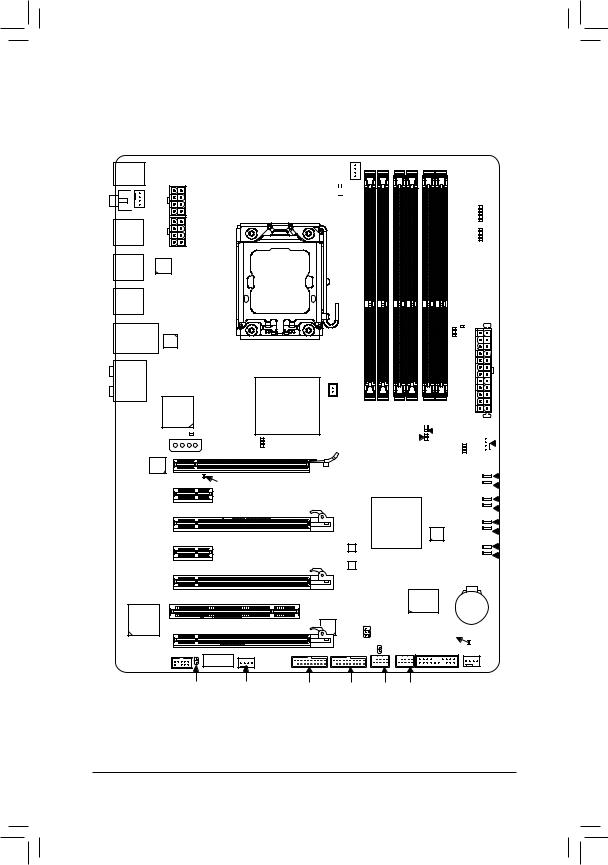
G1.Assassin Motherboard Layout
KB_MS
COAXIAL
R_USB
USB30_2
SYS FAN |
ATX_12V_2X |
|
SYSTEM2 Temp. sensor 

ATX_12V_2X_1
VLI VL810
CPU_FAN
CPU Voltage L1/2/3 

CPU TEMP L1/2 

FREQ. LED
LGA1366
PHASE LED
USB30_1
Marvell 88E1118R
USB_LAN
AUDIO |
|
|
Bigfoot Killer |
Intel® X58 |
|
E2100 |
|
|
|
LAN_LED |
NB Voltage L1/2/3 |
PCIE_12V_1 |
PCIEX16_1 |
|
Renesas |
|
|
|
|
|
D720200 |
|
|
PCIEX1_1 |
SYSTEM1 Temp. |
|
sensor |
||
|
||
PCIEX8_1 |
|
|
PCIEX1_2 |
|
|
PCIEX16_2 |
|
G1.Assassin |
|
HP_PWR |
2 |
|
DDR3_ |
M_BIOS
B_BIOS
DDRVoltage LED SYSTEM3Temp. sensor |
ATX |
|
DDR3 1 DDR3 4 DDR3 3 |
DDR3 6 DDR3 5 |
|
|
|
|
|
|
|
|||
|
|
|
|
|
|
|
|
|
FAN3 |
||
|
|
|
|
|
|
|
|
|
|
|
|
|
|
DDR PHASE |
|
|
|
|
|||||
|
|
|
|
|
|
||||||
|
|
LED |
|
|
|
|
|
|
|
||
LED |
SB Voltage L1/2/3 |
|
|
||||||||
|
|
|
|
|
|||||||
|
|
|
|
|
|
|
|
|
|
||
PHASE |
|
|
|
|
|
|
|
|
|
SATA2_1 |
|
NB |
|
|
|
|
|
|
|
|
|
SATA2_0 |
|
|
|
|
|
|
|
|
|
|
|||
|
|
|
|
|
|
|
|
|
SATA2_3 |
||
|
|
|
|
|
|
|
|
|
|||
|
|
Marvell |
|
|
|
|
|
|
SATA2_2 |
||
|
|
|
|
|
|
|
|
||||
|
|
|
|
|
|
|
|
SATA2_5 |
|||
|
|
|
|
|
|
|
|
||||
Intel® ICH10R |
88SE9182 |
|
|
|
|
|
|||||
|
|
|
|
|
|
|
|
|
|
|
SATA2_4 |
|
|
|
|
|
|
|
|
|
|
|
|
|
|
|
|
|
|
|
|
|
|
|
GSATA3_7 |
|
|
|
|
|
|
|
|
|
|
|
|
iTE IT8720 |
|
|
|
|
|
|
GSATA3_6 |
||||
|
|
|
|
|
|
||||||
|
|
|
|
|
|
|
|||||
|
|
|
|
|
|
|
|||||
|
PCI |
|
|
|
|
BAT |
CREATIVE |
|
|
VLI VL810 |
|
|
|
|
|
OC_BUTTON |
|
|
||
CA20K2 |
PCIEX8_2 |
|
|
System Temperaure |
||
|
|
|
|
|||
|
|
|
|
CLR_CMOS |
sensor |
|
|
|
|
|
F_PANEL |
FAN2 |
|
|
F_AUDIO |
|
|
|
||
|
PCIE_12V_2 |
|
|
|
|
|
|
SPDIF_O |
FAN1 |
F_USB30_2 F_USB30_1 F_USB2 F_USB1 |
|
||
- 7 -
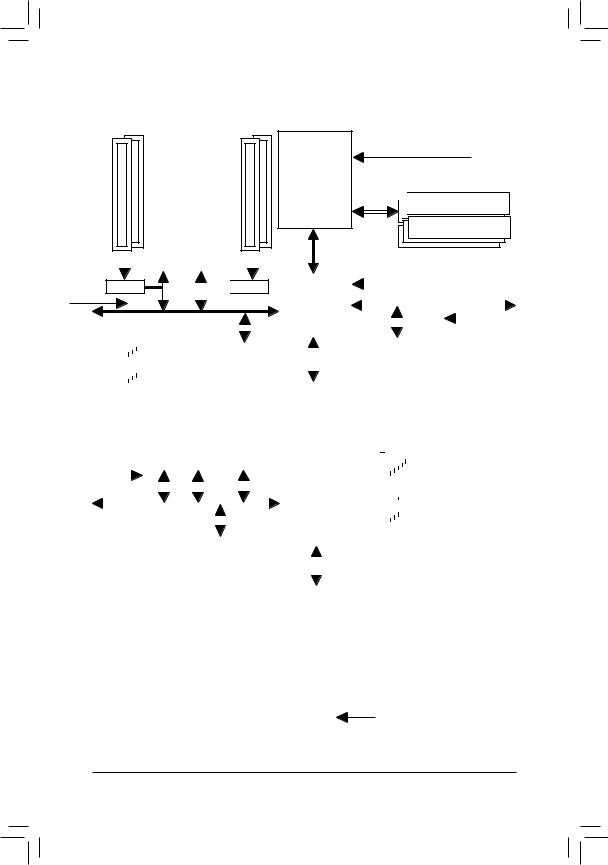
G1.Assassin Motherboard Block Diagram
2 PCI Express x8 |
2 PCI Express x8 |
 x8
x8
PCIe CLK
(100 MHz) Switch
|
|
|
|
1 PCI Express x16 |
|
|
|
|
|
1 PCI Express x16 |
|
|
|
|
|
|
|
|
|
|
|||
|
|
|
|
|
|
|
|
|
|
|
|
|
|
|
|
|
|
|
|
|
|
|
|
|
|
|
|
x16 |
|
|
|
x16 |
|
||
|
|
|
|
|
|
|
|
||||
|
|
|
|
|
|
|
|
|
|
|
|
|
|
|
|
|
|
|
|
|
|
|
|
 x8
x8
Switch
|
|
|
|
|
|
|
|
PCI Express Bus |
|
|
|
|
|
|
|
|
x1 |
||||||||||||||||||||
|
|
|
|
|
|
|
|
|
|
|
|
|
|
|
|||||||||||||||||||||||
|
|
|
|
|
|
|
|
|
|
|
|
|
|
|
|
|
|
|
|
|
|
|
|
|
|
|
|
|
|
|
|
||||||
|
|
|
|
|
|
|
|
|
|
|
|
VLI VL810 |
|
|
|
|
|
|
|
|
|
|
|
|
|
|
|||||||||||
|
|
|
|
|
|
|
|
|
|
|
|
|
|
|
|
|
|
|
|
|
|
|
|
|
|
||||||||||||
|
|
|
|
|
|
|
|
|
|
|
|
|
|
|
Hub |
|
|
|
|
|
Renesas |
|
|||||||||||||||
|
|
|
|
|
|
|
|
|
|
|
|
|
|
|
|
|
|
|
|
|
|
||||||||||||||||
|
|
|
|
|
|
|
|
|
|
|
|
|
|
|
|
|
|
|
|
|
|
||||||||||||||||
|
|
|
|
|
|
|
|
|
|
|
|
|
|
|
|
|
|
|
|
|
|
||||||||||||||||
|
|
|
|
|
|
|
|
|
|
|
|
|
|
|
|
|
|
|
|
|
|
|
|
|
|
|
|
|
D720200 |
|
|||||||
|
|
|
|
|
|
|
|
|
|
|
|
|
|
|
|
|
|
|
|
|
|
|
|
|
|
|
|
|
|||||||||
|
|
|
|
|
|
|
|
|
|
|
|
VLI VL810 |
|
|
|
|
|
|
|
|
|
|
|
|
|
|
|||||||||||
|
|
|
|
|
|
|
|
|
|
|
|
|
|
|
Hub |
|
|
|
|
|
|
|
|
|
|
|
|
|
|
||||||||
|
|
|
|
|
|
|
|
|
|
|
|
|
|
|
|
|
|
|
|
|
|
|
|
|
|
|
|
|
|||||||||
|
|
|
|
|
|
|
|
|
|
|
|
|
|
|
|
|
|
|
|
|
|
|
|
|
|
|
|
|
|||||||||
|
|
|
|
|
|
|
|
|
|
|
|
|
|
|
|
|
|
|
|
|
|
|
|
|
|
|
|
|
|||||||||
8 USB 3.0/2.0 |
|
|
|
|
|
|
|
|
|
|
LAN |
||||||||||||||||||||||||||
|
|
|
2 PCI |
|
|
|
|
|
|||||||||||||||||||||||||||||
|
|
|
|
|
|
|
|
|
|
|
|
|
|
|
|
|
|
|
|
|
|
|
|
|
|
|
|
||||||||||
|
|
|
|
|
|
|
|
|
|
|
|
Express x1 |
|
|
|
|
|
RJ45 |
|
|
|
||||||||||||||||
|
|
|
|
|
|
|
|
|
|
|
|
|
|
|
|
|
|
|
|
|
|
|
|
|
|
|
|
|
|
|
|
|
|
|
|
|
|
|
|
|
|
|
|
|
|
|
|
|
|
|
|
|
|
|
|
|
|
|
|
|
|
|
|
|
|
|
Marvell |
|
|
|
|||||
|
PCIe CLK |
|
|
|
|
|
|
|
|
|
|
|
|
|
|
|
88E1118R phy |
|
|
||||||||||||||||||
|
|
|
|
|
|
|
|
|
|
|
|
|
|
|
|
|
|
|
|
|
|
|
|
|
|
|
|
||||||||||
|
(100 MHz) |
|
|
|
|
|
|
|
|
|
|
|
|
|
BigFoot Killer E2100 |
||||||||||||||||||||||
|
|
|
|
|
|
|
|
|
x1 |
|
|
|
|
x1 |
|
|
|
|
|
|
|
|
|
|
|
|
|
|
x1 |
||||||||
|
|
|
|
|
|
|
|
|
|
|
|
|
|
|
|
|
|
|
|
|
|
|
|
|
|
|
|||||||||||
|
|
|
|
|
|
|
|
|
|
|
|
|
|
|
|
|
|
|
|
||||||||||||||||||
|
|
|
|
|
|
|
|
|
|
|
|
|
|
|
|
|
|
|
|
|
|
|
|
|
|
|
|
|
|
|
|
|
|
|
|
|
|
|
|
|
|
|
|
|
|
|
|
|
|
|
|
|
|
|
|
|
|
|
|
|
x1 |
|
|
|
|
|
|
|
|
|
|
|
|||
|
|
|
|
|
|
|
|
|
|
|
|
|
|
|
|
|
|
|
|
|
|
|
|
|
|
|
|
|
|
|
|
||||||
|
|
|
|
|
|
|
|
|
|
|
|
|
|
|
|
|
|
|
|
|
|
|
|
|
|
|
|
|
|
|
|
|
|
|
|
|
|
|
|
|
|
|
|
|
|
|
|
|
|
|
|
|
|
|
|
|
|
CREATIVE |
|
|
|
|
|
|
|
||||||||||
|
|
|
|
|
|
|
|
|
|
|
|
|
|
|
|
|
|
|
|
|
|
|
|
|
|
|
|||||||||||
|
|
|
|
|
|
|
|
|
|
|
|
|
|
|
|
|
|
|
|
|
|
|
|
|
|||||||||||||
|
|
|
|
|
|
|
|
|
|
|
|
|
|
|
|
|
|
|
|
|
|
CA20K2 |
|
|
|
|
|
|
|
||||||||
|
|
|
|
|
|
|
|
|
|
|
|
|
|
|
|
|
|
|
|
|
|
|
|
|
|
|
|
|
|
|
|
|
|
|
|
|
|
|
|
|
|
|
|
|
|
|
|
|
|
|
|
|
|
|
|
|
|
|
|
|
|
|
|
|
|
|
|
|
|
|
|
|
|
|
|
|
|
|
|
|
|
|
|
|
|
|
|
Out |
|
|
|
In |
|
|
Out |
||||||||||||||||||
|
|
|
|
|
|
|
|
|
|
|
|
Out |
|
|
|||||||||||||||||||||||
|
|
|
|
|
|
|
|
|
|
|
|
|
|
Out Out MIC |
|
|
|
Line |
|
|
|||||||||||||||||
|
|
|
|
|
|
|
|
|
|
|
|
Speaker Speaker Speaker |
Line |
|
|
S/PDIF |
|||||||||||||||||||||
|
|
|
|
|
|
|
|
|
|
|
|
Surround |
|
|
|
|
|
|
|
|
|
|
|
|
|
|
|||||||||||
|
|
|
|
|
|
|
|
|
|
|
|
|
|
Center/Subwoofer Side |
|
|
|
|
|
|
|
|
|
|
|
|
|
|
|||||||||
CPU CLK+/- (133 MHz)
LGA1366
CPU DDR3 2200/1333/1066/800 MHz

 Dual/3 Channel Memory
Dual/3 Channel Memory
QPI
Interface
|
|
|
|
|
|
|
|
|
|
IOH CLK (133 MHz) |
|
||||||||||||||||||||||||||||
|
|
|
|
|
|
|
|
|
|
||||||||||||||||||||||||||||||
Intel® X58 |
|
|
|
|
|
|
|
PCI Express Bus |
|||||||||||||||||||||||||||||||
|
|
|
|
|
|
x2 |
|
|
|
|
|
|
|
|
|
|
|
|
|
|
|
|
|
|
|
|
|
|
|||||||||||
|
|
|
|
|
|
|
|
|
|
|
|
|
|
|
|
|
|
|
|
|
|
|
|
|
|
|
|||||||||||||
|
|
|
|
|
|
|
|
|
|
|
|
|
|
|
|
|
PCIe CLK |
||||||||||||||||||||||
|
|
|
|
|
|
|
|
|
|
|
|
|
|
|
|
|
|
|
|
|
|
|
|
|
|
|
|
|
|
|
|
|
|||||||
|
|
|
|
|
|
|
|
|
|
|
|
|
|
|
|
|
|
|
|
|
|
|
|
|
|
|
|
|
|
|
|
|
(100 MHz) |
||||||
|
|
|
|
|
|
|
|
|
|
|
|
|
|
|
|
|
|
|
|
|
|
|
|
||||||||||||||||
|
|
|
|
|
|
|
|
|
|
|
|
|
|
Marvell |
|
|
|
|
|
|
|||||||||||||||||||
|
|
|
|
|
|
|
|
|
|
|
88SE9182 |
|
|||||||||||||||||||||||||||
|
|
|
|
|
|
|
|
|
|
|
|
|
|
|
|
|
|
|
|
|
|
|
|
|
|
|
2 SATA 6Gb/s |
||||||||||||
|
|
|
|
|
|
|
|
|
|
|
|
|
|
|
|
|
|
|
|
|
|
|
|
|
|
|
|||||||||||||
|
|
|
|
|
|
|
|
|
|
|
|
|
|
|
|
|
|
|
|
|
|
|
|
|
|
|
|
|
|
|
|
|
|
|
|
|
|
|
|
Intel® ICH10R |
|
|
|
|
|
Dual BIOS |
|
|
|
|
|
|
|
|
|
|
|||||||||||||||||||||||
|
|
|
|
|
|
|
|
|
|
|
|
|
|
|
|
|
|
|
|
|
|
|
|
|
|
|
|
|
|
|
|
|
|
|
|||||
|
|
|
|
|
|
|
|
|
|
|
|
|
|
|
|
|
|
|
|
|
|
6 SATA 3Gb/s |
|||||||||||||||||
|
|
|
|
|
|
|
|
|
|
|
|
|
|
|
|
|
|
|
|
|
|
|
|
8 USB 2.0/1.1 |
|||||||||||||||
|
|
|
|
|
|
LPC |
|
|
|
|
|
|
|
|
|
|
|
|
|
|
|
|
|
|
|
|
|
|
|
|
|
||||||||
|
|
|
|
|
|
|
|
|
|
|
|
|
|
|
|
|
|
|
|
|
|
|
|
|
|
|
|
|
|
|
|
|
|
||||||
|
|
|
|
|
|
|
Bus |
|
IT8720 |
|
|
|
|
|
|
|
|
|
|
|
|
||||||||||||||||||
PCI Bus |
|
|
|
|
|
|
|
|
|
|
|
|
|
|
|
|
|||||||||||||||||||||||
|
|
|
|
|
|
|
|
|
|
|
|
|
|
|
|
|
|
|
|
|
|
|
|||||||||||||||||
|
|
|
|
|
|
|
|
|
|
|
|
|
|
|
|
|
|
|
|
|
|
|
|
|
|
|
|
|
|
|
|
|
|
|
|
|
|
||
|
|
|
|
|
|
|
|
|
|
|
|
|
|
|
|
|
|
|
|
|
|
|
|
|
|
|
|
|
|
|
PS/2 KB/Mouse |
|
|||||||
|
|
|
|
|
|
|
|
|
|
|
|
|
|
|
|
|
|
|
|
|
|
|
|
|
|
|
|
|
|
|
|
|
|
|
|
|
|
|
|
|
|
|
|
|
|
|
|
|
|
|
|
|
|
|
|
|
|
|
|
|
|
|
|
|
|
|
|
|
|
|
|
|
|
|
|
|
|
|
|
|
|
|
|
|
|
|
|
|
|
|
|
|
|
|
|
|
|
|
|
|
|
|
|
|
|
|
|
|
|
|
|
|
|
|
|
|
|
|
|
1 PCI
PCI CLK
(33 MHz)
- 8 -

Chapter 1 Hardware Installation
1-1 Installation Precautions
The motherboard contains numerous delicate electronic circuits and components which can become damaged as a result of electrostatic discharge (ESD). Prior to installation, carefully read the user's manual and follow these procedures:
•Prior to installation, do not remove or break motherboard S/N (Serial Number) sticker or warranty sticker provided by your dealer. These stickers are required for warranty validation.
•Always remove the AC power by unplugging the power cord from the power outlet before installing or removing the motherboard or other hardware components.
•When connecting hardware components to the internal connectors on the motherboard, make sure they are connected tightly and securely.
•When handling the motherboard, avoid touching any metal leads or connectors.
•It is best to wear an electrostatic discharge (ESD) wrist strap when handling electronic components such as a motherboard, CPU or memory. If you do not have an ESD wrist strap, keep your hands dry and first touch a metal object to eliminate static electricity.
•Prior to installing the motherboard, please have it on top of an antistatic pad or within an electrostatic shielding container.
•Before unplugging the power supply cable from the motherboard, make sure the power supply has been turned off.
•Before turning on the power, make sure the power supply voltage has been set according to the local voltage standard.
•Before using the product, please verify that all cables and power connectors of your hardware components are connected.
•To prevent damage to the motherboard, do not allow screws to come in contact with the motherboard circuit or its components.
•Make sure there are no leftover screws or metal components placed on the motherboard or within the computer casing.
•Do not place the computer system on an uneven surface.
•Do not place the computer system in a high-temperature environment.
•Turning on the computer power during the installation process can lead to damage to system components as well as physical harm to the user.
•If you are uncertain about any installation steps or have a problem related to the use of the product, please consult a certified computer technician.
- 9 - |
Hardware Installation |

1-2 |
Product Specifications |
|||
|
|
|
|
|
|
|
CPU |
|
Support for an Intel® Core™ i7 series processor in the LGA1366 package |
|
|
|
|
(Go to GIGABYTE's website for the latest CPU support list.) |
|
|
|
L3 cache varies with CPU |
|
|
|
QPI |
|
4.8GT/s, 6.4GT/s |
|
|
|
|
|
|
|
Chipset |
North Bridge: Intel® X58 Express Chipset |
|
|
|
South Bridge: Intel® ICH10R |
||
|
|
|
||
|
|
Memory |
|
6 x 1.5V DDR3 DIMM sockets supporting up to 24 GB of system memory |
|
|
|
|
* Due to Windows 32-bit operating system limitation, when more than 4 GB of physical |
|
|
|
|
memory is installed, the actual memory size displayed will be less than 4 GB. |
|
|
|
3/Dual channel memory architecture |
|
|
|
|
Support for DDR3 2200/1333/1066/800 MHz memory modules |
|
|
|
|
Support for non-ECC memory modules |
|
|
|
|
Support for Extreme Memory Profile (XMP) memory modules |
|
|
|
|
|
(Go to GIGABYTE's website for the latest supported memory speeds and memory |
|
|
|
|
modules.) |
|
|
Audio |
|
1 x Creative CA20K2 chip |
|
|
|
Support for Dolby® Digital Live and DTS™ Connect |
|
|
|
|
Support for X-Fi Xtreme Fidelity® and EAX® Advanced HD™ 5.0 technologies |
|
|
|
|
High Definition Audio |
|
|
|
|
|
2/4/5.1/7.1-channel |
|
|
|
Support for S/PDIF Out |
|
|
|
LAN |
1 x Bigfoot Killer E2100 chip (10/100/1000 Mbit) |
|
|
|
1 x Marvell 88E1118R phy |
||
|
|
|
||
|
|
Expansion Slots |
|
2 x PCI Express x16 slots, running at x16 (PCIEX16_1, PCIEX16_2) |
|
|
|
|
* For optimum performance, if only one PCI Express graphics card is to be installed, be |
|
|
|
|
sure to install it in the PCIEX16_1 slot; if you are installing two PCI Express graphics |
cards, it is recommended that you install them in the PCIEX16_1 and PCIEX16_2 slots.
|
2 x PCI Express x16 slots, running at x8 (PCIEX8_1, PCIEX8_2) |
|
|
|
* The PCIEX8_1 slot shares bandwidth with the PCIEX16_1 slot and the PCIEX8_2 |
|
|
slot with PCIEX16_2. The PCIEX16_1/PCIEX16_2 slot will operate at up to x8 mode |
|
|
when the PCIEX8_1/PCIEX8_2 is populated. |
|
(The PCIEX16_1, PCIEX16_2, PCIEX8_1, and PCIEX8_2 slots conform to PCI |
|
|
Express 2.0 standard.) |
|
|
2 x PCI Express x1 slots |
|
|
1 x PCI slot |
|
Multi-Graphics |
Support for 3-Way/2-Way NVIDIA SLI technology and 4-Way/3-Way/2-Way ATI |
|
Technology |
CrossFireX™ technology |
|
Storage Interface |
South Bridge: |
|
|
- |
6 x SATA 3Gb/s connectors (SATA2_0~SATA2_5) supporting up to 6 SATA |
|
|
3Gb/s devices |
-Support for SATA RAID 0, RAID 1, RAID 5, and RAID 10Marvell 88SE9182:
-2 x SATA 6Gb/s connectors (GSATA3_6, GSATA3_7) supporting up to 2 SATA 6Gb/s devices
-Support for SATA RAID 0 and RAID 1
Hardware Installation |
- 10 - |

USB |
|
South Bridge: |
|
|
|
- |
Up to 8 USB 2.0/1.1 ports (4 on the back panel, 4 via the USB brackets |
|
|
|
connected to the internal USB headers) |
|
1 x Renesas D720200 chip and 2 x VLI VL810 hubs: |
||
|
|
- |
Up to 8 USB 3.0/2.0 ports (4 on the back panel, 4 via the USB brackets |
|
|
|
connected to the internal USB headers) |
|
|
|
* The USB 2.0 signals of the USB 3.0/2.0 ports are from the South Bridge. |
Internal |
1 x 24-pin ATX main power connector |
||
Connectors |
2 x 8-pin ATX 12V power connectors |
||
|
2 x 4-pin PCIe 12V power connectors |
||
|
2 x SATA 6Gb/s connectors |
||
|
6 x SATA 3Gb/s connectors |
||
|
1 x CPU fan header |
||
|
1 x system fan header |
||
|
3 x fan headers |
||
|
1 x front panel header |
||
|
1 x front panel audio header |
||
|
1 x S/PDIF Out header |
||
|
2 x USB 2.0/1.1 headers |
||
|
2 x USB 3.0/2.0 headers |
||
|
1 x clearing CMOS jumper |
||
|
1 x Quick Boost button header |
||
|
1 x heatsink LED power connector |
||
Back Panel |
1 x PS/2 keyboard port |
||
Connectors |
1 x PS/2 mouse port |
||
|
1 x optical S/PDIF Out connector |
||
|
1 x coaxial S/PDIF Out connector |
||
|
4 x USB 2.0/1.1 ports |
||
|
4 x USB 3.0/2.0 ports |
||
|
1 x RJ-45 port |
||
|
5 x audio jacks (Center/Subwoofer Speaker Out, Rear Speaker Out, Side Speaker |
||
|
|
Out, Line In/Mic In, Line Out) |
|
I/O Controller |
|
iTE IT8720 chip |
|
|
|
|
|
Hardware |
|
System voltage detection |
|
Monitor |
|
CPU/System temperature detection |
|
CPU/System fan speed detectionCPU overheating warning
CPU/System fan fail warningCPU/System fan speed control
*Whether the CPU/system fan speed control function is supported will depend on the CPU/system cooler you install.
BIOS |
|
2 x 16 Mbit flash |
|
|
Use of licensed AWARD BIOS |
Support for DualBIOS™
PnP 1.0a, DMI 2.0, SM BIOS 2.4, ACPI 1.0b
- 11 - |
Hardware Installation |

Unique Features |
|
Support for @BIOS |
|
|
|
Support for Q-Flash |
|
|
Support for Xpress BIOS Rescue |
||
|
Support for Download Center |
||
|
Support for Xpress Install |
||
|
Support for Xpress Recovery2 |
||
|
Support for EasyTune |
||
|
|
* Available functions in EasyTune may differ by motherboard model. |
|
|
Support for Dynamic Energy Saver™ 2 |
||
|
Support for Smart 6™ |
||
|
Support for Auto Green |
||
|
Support for eXtreme Hard Drive (X.H.D) |
||
|
Support for ON/OFF Charge |
||
|
Support for Cloud OC |
||
|
|
Support for Q-Share |
|
Bundled |
|
Norton Internet Security (OEM version) |
|
Software |
|||
|
|
||
Operating |
|
Support for Microsoft® Windows® 7/Vista/XP |
|
System |
|||
|
|
||
Form Factor |
|
XL-ATX Form Factor; 34.5cm x 26.3cm |
|
* GIGABYTE reserves the right to make any changes to the product specifications and product-related information without prior notice.
Hardware Installation |
- 12 - |

1-3 Installing the CPU and CPU Cooler
Read the following guidelines before you begin to install the CPU:
•Make sure that the motherboard supports the CPU.
(Go to GIGABYTE's website for the latest CPU support list.)
•Always turn off the computer and unplug the power cord from the power outlet before installing the CPU to prevent hardware damage.
•Locate the pin one of the CPU. The CPU cannot be inserted if oriented incorrectly. (Or you may locate the notches on both sides of the CPU and alignment keys on the CPU socket.)
•Apply an even and thin layer of thermal grease on the surface of the CPU.
•Do not turn on the computer if the CPU cooler is not installed, otherwise overheating and damage of the CPU may occur.
•Set the CPU host frequency in accordance with the CPU specifications. It is not recommended that the system bus frequency be set beyond hardware specifications since it does not meet the standard requirements for the peripherals. If you wish to set the frequency beyond the standard specifications, please do so according to your hardware specifications including the CPU, graphics card, memory, hard drive, etc.
1-3-1 Installing the CPU
A. Locate the alignment keys on the motherboard CPU socket and the notches on the CPU.
LGA1366 CPU Socket |
Pin One Corner of the CPU Socket |
|
|
|
|
|
|
|
|
|
Alignment Key |
Alignment Key |
|
|
|
|
|
|
|
|
|
||
|
|
|
|
|
|
|
|
|
LGA1366 CPU |
Triangle Pin One Marking on the CPU |
|
|
|
|
|
|
|
|
|
||
|
|
|
|
|
|
|
|
|
||
|
|
|
|
|
|
|
|
|
||
|
|
|
|
|
|
|
|
|
||
|
|
|
|
|
|
|
|
|
||
|
|
|
|
|
|
|
|
|
|
|
|
|
|
|
|
|
|
|
|
|
|
Notch |
Notch |
- 13 - |
Hardware Installation |

B. Follow the steps below to correctly install the CPU into the motherboard CPU socket.
Before installing the CPU, make sure to turn off the computer and unplug the power cord from the power outlet to prevent damage to the CPU.
Step 1:
Gently press the CPU socket lever handle down and away from the socket with your finger. Then completely lift the CPU socket lever.
Step 3:
Use your thumb and index finger to hold the protective socket cover as indicated and lift it up vertically. (DO NOT touch socket contacts. To protect the CPU socket, always replace the protective socket cover when the CPU is not installed.)
Step 5:
Once the CPU is properly inserted, replace the load plate and push the CPU socket lever back into its locked position.
Hardware Installation |
- 14 - |
Step 2:
Lift the metal load plate from the CPU socket.
Step 4:
Hold the CPU with your thumb and index fingers.
Align the CPU pin one marking (triangle) with the pin one corner of the CPU socket (or you may align the CPU notches with the socket alignment keys) and gently insert the CPU into position.
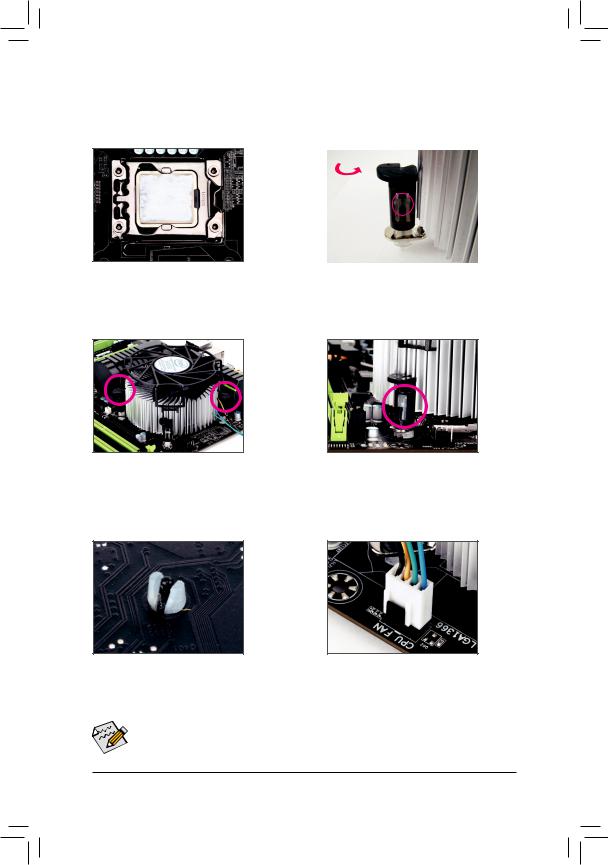
1-3-2 Installing the CPU Cooler
Follow the steps below to correctly install the CPU cooler on the motherboard. (The following procedure uses Intel® boxed cooler as the example cooler.)
|
|
|
|
|
|
Male Push |
|
|
|
|
|
|
|
Direction of the |
|
|
|
Pin |
||
Arrow Sign on |
|
|
|
|
||
the Male Push |
|
|
|
|
The Top |
|
Pin |
|
|
|
|||
|
|
|
of Female |
|||
|
|
|
|
|
|
Push Pin |
|
|
|
|
|
|
Female |
|
|
|
|
|
|
Push Pin |
|
|
|
|
|
|
|
Step 1:
Apply an even and thin layer of thermal grease on the surface of the installed CPU.
Step 3:
Place the cooler atop the CPU, aligning the four push pins through the pin holes on the motherboard. Push down on the push pins diagonally.
Step 5:
After the installation, check the back of the motherboard. If the push pin is inserted as the picture above shows, the installation is complete.
Step 2:
Before installing the cooler, note the direction of the arrow sign  on the male push pin. (Turning the push pin along the direction of arrow is to remove the cooler, on the contrary, is to install.)
on the male push pin. (Turning the push pin along the direction of arrow is to remove the cooler, on the contrary, is to install.)
Step 4:
You should hear a "click" when pushing down each push pin. Check that the Male and Female push pins are joined closely. (Refer to your CPU cooler installation manual for instructions on installing the cooler.)
Step 6:
Finally, attach the power connector of the CPU cooler to the CPU fan header (CPU_FAN) on the motherboard.
Use extreme care when removing the CPU cooler because the thermal grease/tape between the CPU cooler and CPU may adhere to the CPU. Inadequately removing the CPU cooler may damage the CPU.
- 15 - |
Hardware Installation |
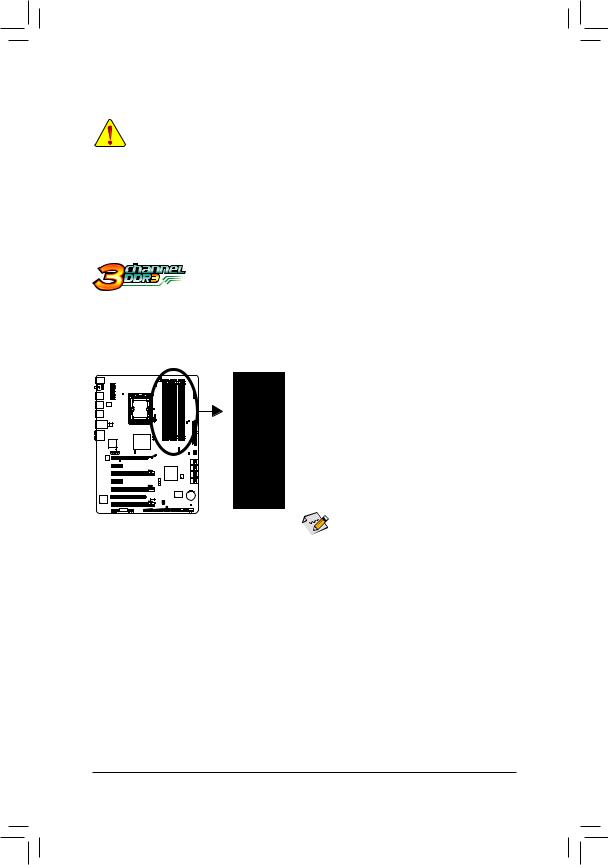
1-4 Installing the Memory
Read the following guidelines before you begin to install the memory:
•Make sure that the motherboard supports the memory. It is recommended that memory of the same capacity, brand, speed, and chips be used.
(Go to GIGABYTE's website for the latest supported memory speeds and momery moudles.)
•Always turn off the computer and unplug the power cord from the power outlet before installing the memory to prevent hardware damage.
•Memory modules have a foolproof design. A memory module can be installed in only one direction. If you are unable to insert the memory, switch the direction.
1-4-1 Dual/3 Channel Memory Configuration
This motherboard provides six DDR3 memory sockets and supports Dual/3 Channel Technology. After the memory is installed, the BIOS will automatically detect the

 specifications and capacity of the memory. Dual or 3 Channel memory mode may double or triple the original memory bandwidth.
specifications and capacity of the memory. Dual or 3 Channel memory mode may double or triple the original memory bandwidth.
The six DDR3 memory sockets are divided into three channels:
 Channel 0: DDR3_1, DDR3_2
Channel 0: DDR3_1, DDR3_2
 Channel 1: DDR3_3, DDR3_4
Channel 1: DDR3_3, DDR3_4  Channel 2: DDR3_5, DDR3_6
Channel 2: DDR3_5, DDR3_6
DDR3_2 DDR3_1 DDR3_4 DDR3_3 DDR3_6 DDR3_5
 Dual Channel Memory Configurations Table
Dual Channel Memory Configurations Table
|
|
DDR3_2 |
DDR3_1 |
DDR3_4 |
DDR3_3 |
DDR3_6 |
DDR3_5 |
Two Modules |
- - |
DS/SS |
- - |
DS/SS |
- - |
- - |
|
|
|
|
|
|
|
|
|
Four Modules |
DS/SS |
DS/SS |
DS/SS |
DS/SS |
- - |
- - |
|
|
|
|
|
|
|
|
|
 3 Channel Memory Configurations Table
3 Channel Memory Configurations Table
|
|
DDR3_2 |
DDR3_1 |
DDR3_4 |
DDR3_3 |
DDR3_6 |
DDR3_5 |
Three Modules |
- - |
DS/SS |
- - |
DS/SS |
- - |
DS/SS |
|
|
|
|
|
|
|
|
|
Four Modules |
DS/SS |
DS/SS |
- - |
DS/SS |
- - |
DS/SS |
|
|
|
|
|
|
|
|
|
Six Modules |
DS/SS |
DS/SS |
DS/SS |
DS/SS |
DS/SS |
DS/SS |
|
|
|
|
|
|
|
|
|
(SS=Single-Sided, DS=Double-Sided, "- -"=No Memory)

 If only one DDR3 memory module is installed, be sure
If only one DDR3 memory module is installed, be sure  to install it in the DDR3_1 or DDR3_3.
to install it in the DDR3_1 or DDR3_3.
Due to chipset limitation, read the following guidelines before installing the memory in Dual or 3 Channel mode.
Dual Channel--
1.Dual Channel mode cannot be enabled if only one DDR3 memory module is installed.
2.When enabling Dual Channel mode with two or four modules, it is recommended that memory of the same capacity, brand, speed, and chips be used. When enabling Dual Channel mode with two memory modules, be sure to install them in the DDR3_1 and DDR3_3 sockets.
3 Channel--
1.3 Channel mode cannot be enabled if only one or two DDR3 memory modules are installed.
2.When enabling 3 Channel mode with three, four or six modules, it is recommended that memory of the same capacity, brand, speed, and chips be used. When enabling 3 Channel mode with three memory modules, be sure to install them in the DDR3_1, DDR3_3 and DDR3_5 sockets. When enabling 3 Channel mode with four memory modules, be sure to install them in the DDR3_1, DDR3_2, DDR3_3 and DDR3_5 sockets.
Hardware Installation |
- 16 - |
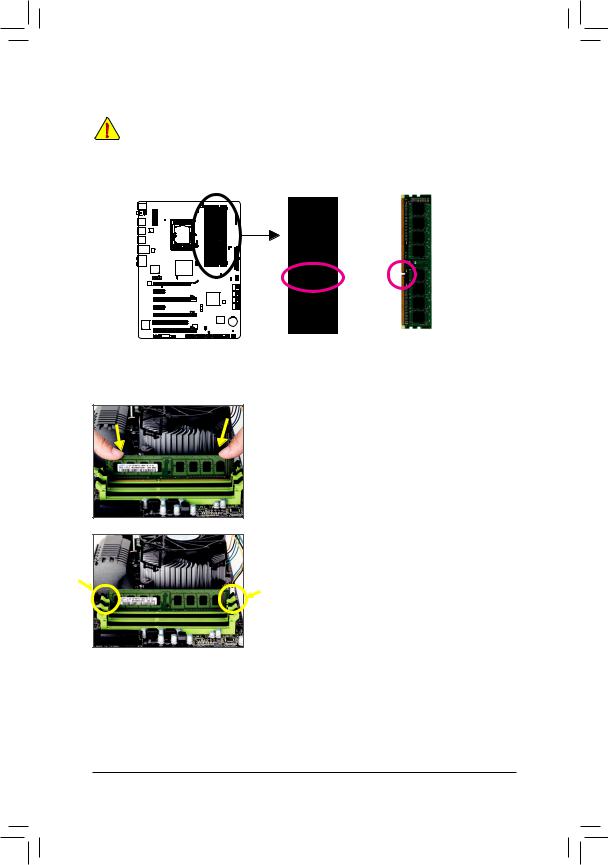
1-4-2 Installing a Memory
Before installing a memory module, make sure to turn off the computer and unplug the power cord from the power outlet to prevent damage to the memory module.
DDR3 and DDR2 DIMMs are not compatible to each other or DDR DIMMs. Be sure to install DDR3 DIMMs on this motherboard.
Notch
DDR3 DIMM
A DDR3 memory module has a notch, so it can only fit in one direction. Follow the steps below to correctly install your memory modules in the memory sockets.
Step 1:
Note the orientation of the memory module. Spread the retaining clips at both ends of the memory socket. Place the memory module on the socket. As indicated in the picture on the left, place your fingers on the top edge of the memory, push down on the memory and insert it vertically into the memory socket.
Step 2:
The clips at both ends of the socket will snap into place when the memory module is securely inserted.
- 17 - |
Hardware Installation |
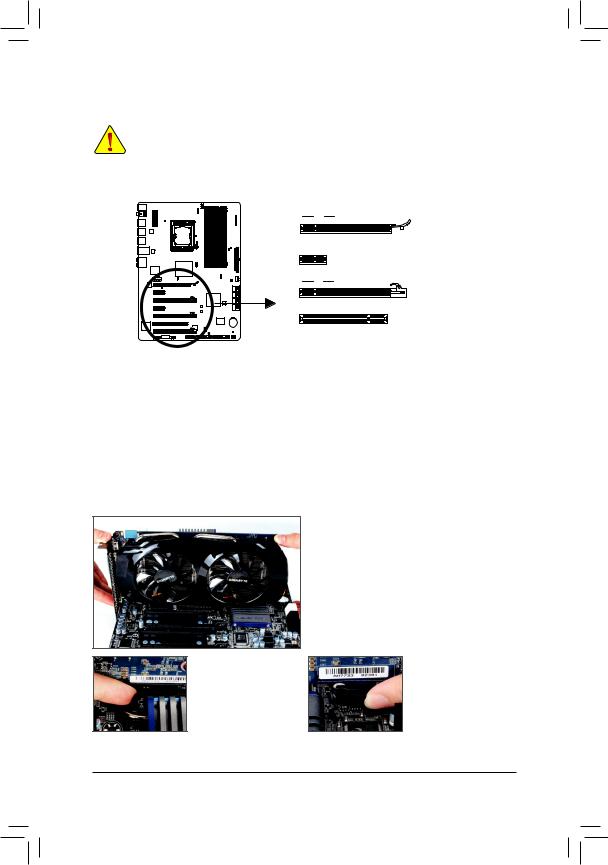
1-5 Installing an Expansion Card
Read the following guidelines before you begin to install an expansion card:
•Make sure the motherboard supports the expansion card. Carefully read the manual that came with your expansion card.
•Always turn off the computer and unplug the power cord from the power outlet before installing an expansion card to prevent hardware damage.
PCI Express x16 Slot (PCIEX16_1)
PCI Express x1 Slot
PCI Express x16 Slot (PCIEX16_2/PCIEX8_1/PCIEX8_2)
PCI Slot
Follow the steps below to correctly install your expansion card in the expansion slot.
1.Locate an expansion slot that supports your card. Remove the metal slot cover from the chassis back panel.
2.Align the card with the slot, and press down on the card until it is fully seated in the slot.
3.Make sure the metal contacts on the card are completely inserted into the slot.
4.Secure the card’s metal bracket to the chassis back panel with a screw.
5.After installing all expansion cards, replace the chassis cover(s).
6.Turn on your computer. If necessary, go to BIOS Setup to make any required BIOS changes for your expansion card(s).
7.Install the driver provided with the expansion card in your operating system.
Example: Installing and Removing a PCI Express Graphics Card:
• Installing a Graphics Card:
Gently push down on the top edge of the card until it is fully inserted into the PCI Express slot. Make sure the card is securely seated in the slot and does not rock.
•Removing the Card from the PCIEX16_1 Slot: Gently push back on the lever on the slot and then lift the card straight out from the slot.
Hardware Installation |
- 18 - |
•R e m o v i n g t h e C a r d from the PCIEX16 _ 2/ PCIEX8_1/PCIEX8_2 Slot: Press the latch at the end of the PCI Express slot to release the card and then pull the card straight up from the slot.

1-6 Setup of ATI CrossFireX™/NVIDIA SLI Configuration
A.System Requirements
-The 2-Way SLI and 2-Way CrossFireX technologies currently support Windows 7, Vista, and XP operating systems
-The 3-Way SLI and 3-Way/4-Way CrossFireX technologies currently support Windows 7 and Vista operating systems
-A CrossFireX/SLI-supported motherboard with two/three/four PCI Express x16 slots and correct driver
-CrossFireX/SLI-supported graphics cards of identical brand and chip and correct driver
( Current GPUs that support 3-Way/4-Way CrossFireX technology include the ATI Radeon HD 3800, HD 4800, and HD 5800 series and AMD Radeon HD 6950 and HD 6970 series. Current GPUs that support 3-Way SLI technology include the NVIDIA 8800 GTX, 8800 Ultra, 9800 GTX, GTX 260, GTX 280, GTX 470, GTX 480, GTX 570, and GTX 580 series.)
-CrossFire (Note 1)/SLI bridge connector(s)
-Apower supply with sufficient power is recommended (Note 2)(Refer to the manual of your graphics cards for the power requirement)
B.Connecting the Graphics Cards
Step 1:
Observe the steps in "1-5 Installing an Expansion Card" and install CrossFireX/SLI graphics cards on the PCI Express x16 slots. (To set up a 2-Way configuration, we recommend installing the graphics cards on the PCIEX16_1 and PCIEX16_2 slots.)
Step 2:
Insert the CrossFireX (Note 1)/SLI bridge connectors into the CrossFireX/SLI gold edge connectors on top of the graphics cards.
Step 3:
Plug the display cable into the graphics card on the PCIEX16_1 slot.
C. Configuring the Graphics Card Driver
C-1. To Enable CrossFireX Function
For 2-Way CrossFireX:
After installing the graphics card driver in the operating system, go to the Catalyst Control Center. Browse to the CrossFireX menu and ensure the Enable CrossFireX™ check box is selected.
For 3-Way CrossFireX:
After installing the graphics card driver in the operating system, go to the Catalyst Control Center. Browse to the CrossFireX menu, select the Enable CrossFireX™ check box, and select the 3 GPUs combination. Click OK to apply.
- 19 - |
Hardware Installation |

For 4-Way CrossFireX:
After installing the graphics card driver in the operating system, go to the Catalyst Control Center. Browse to the CrossFireX menu, select the Enable CrossFireX™ check box, and select the 4 GPUs combination. Click OK to apply.
C-2. To Enable SLI Function
For 2-Way/3-Way SLI:
After installing the graphics card driver in the operating system, go to the NVIDIA Control Panel. Browse to the Set SLI and Physx Configuration screen and ensure Maximize 3D performance is enabled.
(Note 1) The bridge connectors may be needed or not depending on your graphics cards.
(Note 2) When two or more graphics cards are installed, we recommend that you connect the power cables from the power supply to the PCIE_12V_1 and PCIE_12V_2 connectors, or system instability may occur.
 Procedure and driver screen for enabling CrossFireX/SLI technology may differ by graphics cards. Refer to the manual that came with your graphics cards for more information about enabling CrossFireX/SLI technology.
Procedure and driver screen for enabling CrossFireX/SLI technology may differ by graphics cards. Refer to the manual that came with your graphics cards for more information about enabling CrossFireX/SLI technology.
Hardware Installation |
- 20 - |
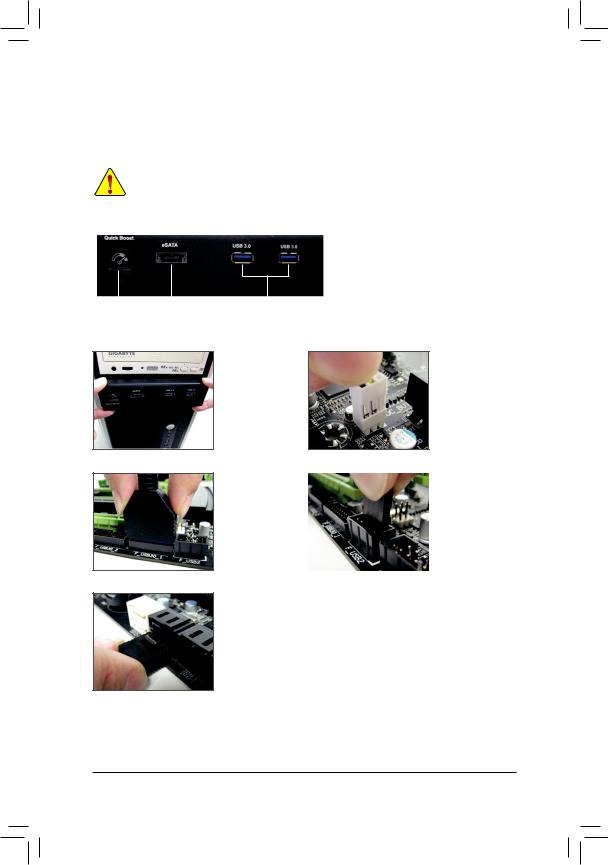
1-7 Installing the 5.25" Front Access Control Panel
The 5.25" Front Access Control Panel allows quick and easy access to USB 3.0/2.0 ports and Power eSATA. It also provides a Quick Boost button that allows you to quickly overclock your CPU in the operation system without the need for a system reboot.
•Turn off your system and the power switch on the power supply before installing or removing the Front Access Control Panel and signal/power cable to prevent damage to hardware.
•Insert the signal cable/power cable securely into the corresponding connectors when installing.
5.25" Front Access Control Panel
The 5.25" Front Access Control Panel kit includes one 5.25" Front Access Control Panel and eight screws used for fastening the panel to the chassis sides.
|
|
|
|
|
Quick Boost Button Power eSATA Port |
USB 3.0/2.0 Ports |
|||
Follow the steps below to install the Front Access Control Panel:
Step 1:
Install the Front Access Control Panel into a free 5.25" bay of your chassis. Then tighten the included screws to both sides of the chassis.
Step 2:
Connect the Quick Boost button's cable to the OC_BUTTON header on the motherboard. (Note 2)
Step 3: |
|
|
Step 4: |
|
|
||
C o n n e c t t h e U S B |
|
|
Connect the Power |
3.0/2.0 ports' cable to |
|
|
eSATA power cable |
the F_USB30_1 or F_ |
|
|
to Pin 1, 3, 5, and 7 |
USB30_2 header on |
|
|
of the F_USB1 or F_ |
the motherboard. |
|
|
USB2 header on the |
|
|
|
motherboard. Be sure |
|
|
|
to connect it in the |
Step 5: |
|
correct orientation. |
|
|
|
||
Connect the Power eSATA signal cable |
to a free SATA port on your mother- |
||
board. |
|
|
|
(Note 1) The components received may vary in appearance from the products illustrated.
(Note 2) In the operating system, you can press the Quick Boost button to overclock the CPU and the button will light red. To return to the defaults, press the button again and the button will light green.
- 21 - |
Hardware Installation |
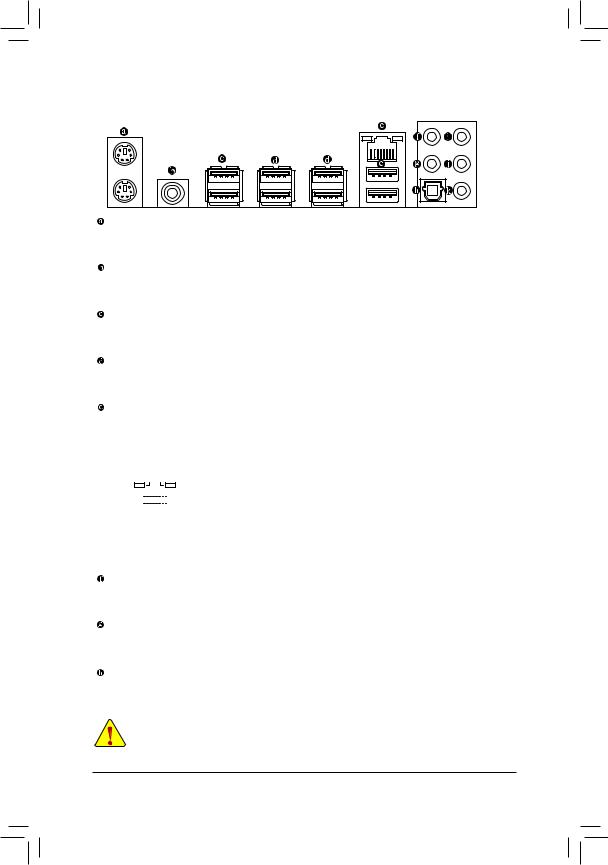
1-8 Back Panel Connectors
PS/2 Keyboard and PS/2 Mouse Port
Use the upper port (green) to connect a PS/2 mouse and the lower port (purple) to connect a PS/2 keyboard.
Coaxial S/PDIF Out Connector
This connector provides digital audio out to an external audio system that supports digital coaxial audio. Before using this feature, ensure that your audio system provides a coaxial digital audio in connector.
USB 2.0/1.1 Port
The USB port supports the USB 2.0/1.1 specification. Use this port for USB devices such as a USB keyboard/mouse, USB printer, USB flash drive and etc.
USB 3.0/2.0 Port
The USB 3.0 port supports the USB 3.0 specification and is compatible to the USB 2.0/1.1 specification. Use this port for USB devices such as a USB keyboard/mouse, USB printer, USB flash drive and etc.
RJ-45 LAN Port
The Gigabit Ethernet LAN port provides Internet connection at up to 1 Gbps data rate. The following describes the states of the LAN port LEDs.
Speed/Activity LED Link LED |
Speed/Activity LED: |
|
Link LED: |
|
||||||||
|
|
|
|
|
|
|
|
State |
Description |
|
State |
Description |
|
|
|
|
|
|
|
|
Orange |
10 Mbps data rate |
|
On |
Linked properly |
|
|
|
|
|
|
|
|
|||||
|
|
|
|
|
|
|
|
|
|
|
Off |
No link |
|
|
|
|
|
|
|
|
Green + |
100 Mbps data rate |
|||
|
|
|
|
|
|
|
|
Orange |
|
|
|
|
|
|
LAN Port |
|
|
|
|
||||||
|
|
Green |
1 Gbps data rate |
|
|
|
||||||
|
|
|
|
|
|
|
|
|
|
|
||
|
|
|
|
|
|
|
|
Blinking |
Network activity |
|
|
|
|
|
|
|
|
|
|
|
Off |
No connection |
|
|
|
Line In/Mic In Jack (Blue)
The line in/Mic in jack. Use this audio jack for line in devices such as optical drive, walkman, microphone, etc.
Line Out Jack (Green)
The line out jack. Use this audio jack for a headphone or 2-channel speaker. This jack can be used to connect front speakers in a 4/5.1/7.1-channel audio configuration.
Optical S/PDIF Out Connector
This connector provides digital audio out to an external audio system that supports digital optical audio. Before using this feature, ensure that your audio system provides an optical digital audio in connector.
•When removing the cable connected to a back panel connector, first remove the cable from your device and then remove it from the motherboard.
•When removing the cable, pull it straight out from the connector. Do not rock it side to side to prevent an electrical short inside the cable connector.
Hardware Installation |
- 22 - |

Center/Subwoofer Speaker Out Jack (Orange)
Use this audio jack to connect center/subwoofer speakers in a 5.1/7.1-channel audio configuration.
Rear Speaker Out Jack (Black)
Use this audio jack to connect rear speakers in a 4/5.1/7.1-channel audio configuration.
Side Speaker Out Jack (Gray)
Use this audio jack to connect side speakers in a 7.1-channel audio configuration.
- 23 - |
Hardware Installation |

1-9 Onboard LEDs
Overvoltage LEDs
This motherboard contains 4 sets of overvoltage LEDs which indicate the overvoltage level of the CPU, memory, North Bridge, and South Bridge.
CPU Voltage |
DDR Voltage |
||
Off: Normal condition |
Off: Normal condition |
||
L1: Level 1 |
(Slight, green) |
L1: Level 1 |
(Slight, green) |
L2: Level 2 |
(Moderate, yellow) |
L2: Level 2 |
(Moderate, yellow) |
L3: Level 3 |
(High, red) |
L3: Level 3 |
(High, red) |
|
|
|
|
|
|
|
|
|
|
|
|
NB Voltage |
SB Voltage |
||
|
|
|
|
|
|
|
|
|
|
|
|
||||
|
|
|
|
|
|
|
|
|
|
|
|
Off: Normal condition |
Off: Normal condition |
||
|
|
|
|
|
|
|
|
|
|
|
|
||||
|
|
|
|
|
|
|
|
|
|
|
|
||||
|
|
|
|
|
|
|
|
|
|
|
|
L1: Level 1 |
(Slight, green) |
L1: Level 1 |
(Slight, green) |
|
|
|
|
|
|
|
|
||||||||
|
|
|
|
|
|
|
|
||||||||
|
|
|
|
|
|
|
|
|
|
|
|
||||
|
|
|
|
|
|
|
|
|
|
|
|
L2: Level 2 |
(Moderate, yellow) |
L2: Level 2 |
(Moderate, yellow) |
|
|
|
|
|
|
|
|
|
|
|
|
L3: Level 3 |
(High, red) |
L3: Level 3 |
(High, red) |
|
|
|
|
|
|
|
|
|
|
|
|
||||
|
|
|
|
|
|
|
|
|
|
|
|||||
|
|
|
|
|
|
|
|
|
|
|
|
||||
Overclock LEDs
The onboard CPU overclock LEDs indicate on which level the CPU is overclocked. The higher the overclock level, the more the number of lighted LEDs.
FREQ. LED
Off: Normal condition
F_LED1~F_LED5: Blue
Temperature Indicator LEDs
The temperature indicator LEDs indicate the temperature level of the CPU. The LEDs are off when the temperature is below 60oC; the green LED lights up when the temperature is between 61~80oC; the red LED is illuminated when the temperature exceeds 80oC.
CPU TEMP
Off: Below 60oC
L1: 61~ 80oC (green)
L2: Over 80oC (red)
Hardware Installation |
- 24 - |

PHASE LED
The number of lighted LEDs indicates the CPU loading. The higher the CPU loading, the more the number of lighted LEDs. To enable the Phase LED display function, please first enable Dynamic Energy Saver 2. Refer to Chapter 4, "Dynamic Energy Saver 2," for more details.
NB PHASE LED
The number of lighted LEDs indicates the North Bridge loading. The higher the North Bridge loading, the more the number of lighted LEDs.
DDR PHASE LED
The number of lighted LEDs indicates the memory loading. The higher the memory loading, the more the number of lighted LEDs.
- 25 - |
Hardware Installation |
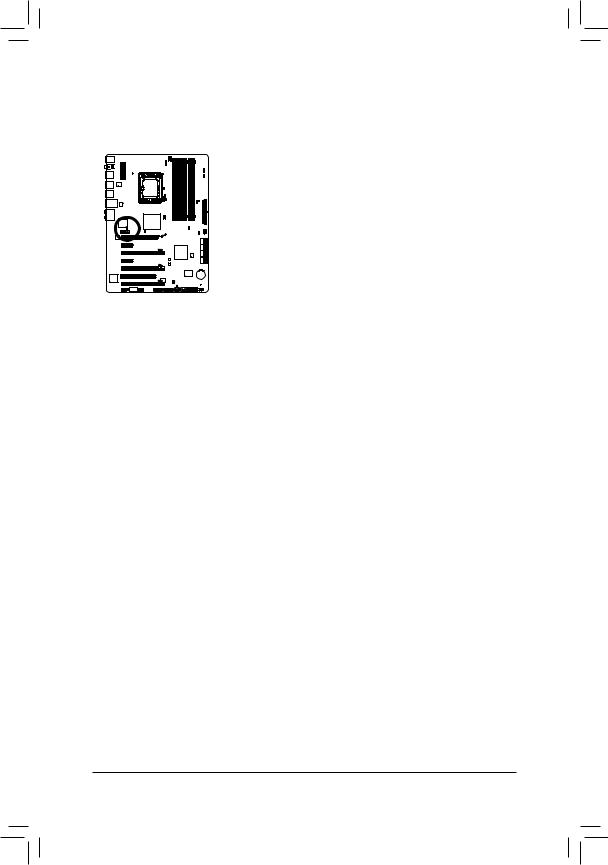
LAN LED
The LAN LED indicates whether the LAN chips are working properly. The LED will light up during the POST if the LAN chips are working properly.
Hardware Installation |
- 26 - |

1-10 Internal Connectors
1 |
4 |
|
|
|
|
|
|
|
|
|
|
5
|
2 |
3 |
15 |
6 |
|
|
7 |
|
8 |
|
16 |
|
17 |
10 |
11 |
3 |
6 |
13 |
14 12 |
9 |
6 |
1) |
ATX_12V_2X/ATX_12V_2X_1 |
10) |
F_AUDIO |
2) |
ATX |
11) |
SPDIF_O |
3) |
PCIE_12V_1/PCIE_12V_2 |
12) |
F_USB1/F_USB2 |
4) |
CPU_FAN |
13) |
F_USB30_1/F_USB30_2 |
5) |
SYS_FAN |
14) |
CLR_CMOS |
6) |
FAN1/2/3 |
15) |
HP_PWR |
7) |
SATA2_0/1/2/3/4/5 |
16) |
BAT |
8) |
GSATA3_6/7 |
17) |
OC_BUTTON |
9) |
F_PANEL |
|
|
Read the following guidelines before connecting external devices:
•First make sure your devices are compliant with the connectors you wish to connect.
•Before installing the devices, be sure to turn off the devices and your computer. Unplug the power cord from the power outlet to prevent damage to the devices.
•After installing the device and before turning on the computer, make sure the device cable has been securely attached to the connector on the motherboard.
- 27 - |
Hardware Installation |
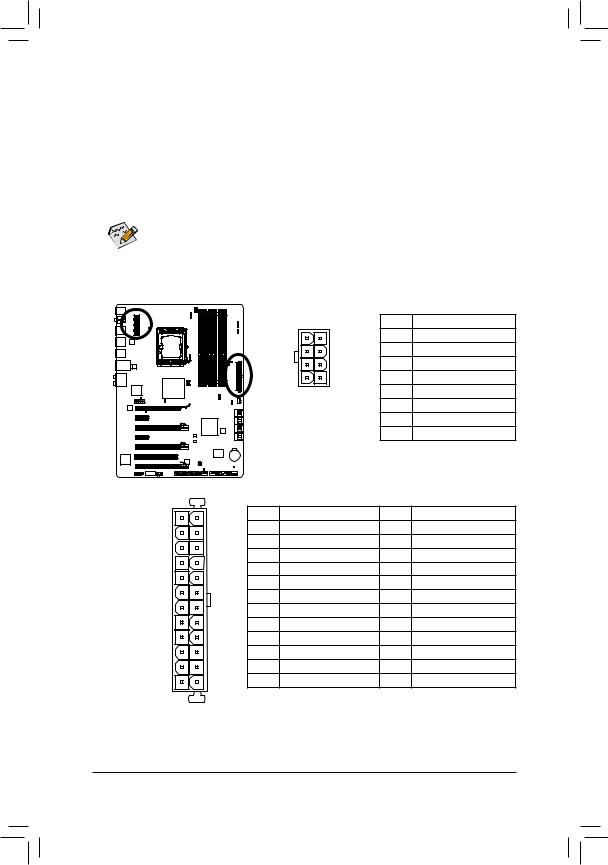
1/2) ATX_12V_2X/ATX_12V_2X_1/ATX (2x4 12V Power Connectors and 2x12 Main Power Connector)
With the use of the power connector, the power supply can supply enough stable power to all the components on the motherboard. Before connecting the power connector, first make sure the power supply is turned off and all devices are properly installed. The power connector possesses a foolproof design. Connect the power supply cable to the power connector in the correct orientation. The 12V power connector mainly supplies power to the CPU. If the 12V power connector is not connected, the computer will not start.
 • Use of a power supply providing a 2x4 12V power connector is recommended by the CPU manufacturer when using an Intel Extreme Edition CPU (130W).
• Use of a power supply providing a 2x4 12V power connector is recommended by the CPU manufacturer when using an Intel Extreme Edition CPU (130W).
•To meet expansion requirements, it is recommended that a power supply that can withstand high power consumption be used (500W or greater). If a power supply is used that does not provide the required power, the result can lead to an unstable or unbootable system.
|
|
|
|
|
ATX_12V_2X/ATX_12V_2X_1: |
|
|
|
|
|
|
Pin No. |
Definition |
|
|
|
8 |
4 |
1 |
GND (Only for 2x4-pin 12V) |
|
|
|
|
|
2 |
GND (Only for 2x4-pin 12V) |
|
|
|
|
|
3 |
GND |
|
|
|
5 |
1 |
4 |
GND |
|
|
ATX_12V_2X/ATX_12V_2X_1 |
5 |
+12V (Only for 2x4-pin 12V) |
||
|
|
6 |
+12V (Only for 2x4-pin 12V) |
|||
|
|
|
|
|
||
|
|
|
|
|
7 |
+12V |
|
|
|
|
|
8 |
+12V |
|
|
ATX: |
|
|
|
|
12 |
24 |
Pin No. |
Definition |
|
Pin No. |
Definition |
1 |
3.3V |
|
13 |
3.3V |
||
|
|
|
||||
|
|
2 |
3.3V |
|
14 |
-12V |
|
|
3 |
GND |
|
15 |
GND |
|
|
4 |
+5V |
|
16 |
PS_ON (soft On/Off) |
|
|
5 |
GND |
|
17 |
GND |
|
|
6 |
+5V |
|
18 |
GND |
|
|
7 |
GND |
|
19 |
GND |
|
|
8 |
Power Good |
|
20 |
-5V |
|
|
9 |
5VSB (stand by +5V) |
21 |
+5V |
|
|
|
10 |
+12V |
|
22 |
+5V |
|
|
11 |
+12V (Only for 2x12-pin ATX) |
23 |
+5V (Only for 2x12-pin ATX) |
|
1 |
13 |
12 |
3.3V (Only for 2x12-pin ATX) |
24 |
GND (Only for 2x12-pin ATX) |
|
ATX
Hardware Installation |
- 28 - |

3)PCIE_12V_1/PCIE_12V_2 (Power Connectors)
The power connectors provide auxiliary power to the onboard PCI Express x16 slots. When two or more graphics cards are installed, we recommend that you connect the power cables from the power supply to the PCIE_12V_1 and PCIE_12V_2 connectors, or system instability may occur.
|
Pin No. |
Definition |
|
1 |
1 |
VCC |
|
|
2 |
GND |
|
PCIE_12V_1 |
3 |
GND |
|
4 |
+12V |
||
|
1
PCIE_12V_2
4/5/6) CPU_FAN/SYS_FAN/FAN1/FAN2/FAN3 (Fan Headers)
All fan headers on this motherboard are 4-pin and support fan speed control function. Most fan headers
possess a foolproof insertion design. When connecting a fan cable, be sure to connect it in the correct orientation (the black connector wire is the ground wire). The speed control function requires the use of a fan with fan speed control design. For optimum heat dissipation, it is recommended that a system fan be installed inside the chassis.
1 |
CPU_FAN: |
|
|
Pin No. |
Definition |
||
|
|||
|
1 |
GND |
|
|
2 |
+12V |
|
CPU_FAN |
3 |
Sense |
|
|
4 |
Speed Control |
|
1 |
SYS_FAN/FAN1/FAN2/FAN3: |
||
|
Pin No. |
Definition |
|
|
1 |
GND |
|
SYS_FAN |
2 |
+12V / Speed Control |
|
3 |
Sense |
||
|
|||
|
4 |
Reserve |
|
1 |
1 |
|
|
FAN1/FAN2 |
|
||
FAN3 |
|
||
•Be sure to connect fan cables to the fan headers to prevent your CPU and system from overheating. Overheating may result in damage to the CPU or the system may hang.
•These fan headers are not configuration jumper blocks. Do not place a jumper cap on the headers.
- 29 - |
Hardware Installation |

7)SATA2_0/1/2/3/4/5 (SATA 3Gb/s Connectors, Controlled by Intel ICH10R)
The SATA connectors conform to SATA 3Gb/s standard and are compatible with SATA 1.5Gb/s standard. Each SATA connector supports a single SATA device. The Intel ICH10R controller supports RAID 0,
RAID 1, RAID 5, and RAID 10. Refer to Chapter 5, "Configuring SATA Hard Drive(s)," for instructions on configuring a RAID array.
|
|
|
|
|
|
|
|
|
|
|
|
|
|
|
|
SATA2_5 |
SATA2_3 |
SATA2_1 |
Pin No. |
Definition |
|
|
|
|
|
|
|
|
|
|
|
|
|
|
|
|
1 |
GND |
|||
|
|
|
|
|
|
|
|
7 |
|
1 |
||||||||||
|
|
|
|
|
|
|
|
|
2 |
TXP |
||||||||||
|
|
|
|
|
|
|
|
7 |
|
1 |
||||||||||
|
|
|
|
|
|
|
|
|
3 |
TXN |
||||||||||
|
|
|
|
|
|
|
|
|
|
|
|
|
|
|
|
SATA2_4 |
SATA2_2 |
SATA2_0 |
|
|
|
|
|
|
|
|
|
|
|
|
|
|
|
|
|
|
4 |
GND |
|||
|
|
|
|
|
|
|
|
|
|
|
|
|
|
|
|
|||||
|
|
|
|
|
|
|
|
|
|
|
|
|
|
|
|
|
|
|
5 |
RXN |
|
|
|
|
|
|
|
|
|
|
|
|
|
|
|
|
|
|
|
|
|
|
|
|
|
|
|
|
|
|
|
|
|
|
|
|
|
|
|
|
6 |
RXP |
|
|
|
|
|
|
|
|
|
|
|
|
|
|
|
|
|
|
|
||
|
|
|
|
|
|
|
|
|
|
|
|
|
|
|
|
|
|
|
||
|
|
|
|
|
|
|
|
|
|
|
|
|
|
|
|
|
|
|
7 |
GND |
|
|
|
|
|
|
|
|
|
|
|
|
|
|
|
|
|
|
|
|
|
|
|
|
|
|
|
|
|
|
|
|
|
|
|
|
|
|
|
|
|
|
|
|
|
|
|
|
|
|
|
|
|
|
|
|
|
|
|
|
|
|
|
|
|
|
|
|
|
|
|
|
|
|
|
|
|
|
|
|
|
|
|
|
|
|
|
|
|
|
|
|
|
|
|
|
|
|
|
|
|
|
|
|
|
|
|
|
|
|
|
|
|
|
|
|
|
|
|
|
|
|
|
|
|
|
|
|
|
|
|
|
|
|
|
|
|
|
|
|
|
|
|
|
|
|
|
|
|
|
|
|
|
|
|
|
|
|
|
|
|
|
|
|
|
|
|
|
8)GSATA3_6/7 (SATA 6Gb/s Connectors, Controlled by Marvell 88SE9182)
The SATA connectors conform to SATA 6Gb/s standard and are compatible with SATA 3Gb/s and SATA 1.5Gb/s standard. Each SATA connector supports a single SATA device. The Marvell 88SE9182 control-
ler supports RAID 0 and RAID 1. Refer to Chapter 5, "Configuring SATA Hard Drive(s)," for instructions on configuring a RAID array.
|
|
|
|
|
|
|
|
|
|
|
|
|
|
|
|
|
|
Pin No. |
Definition |
|
|
|
|
|
|
|
|
|
|
|
|
|
|
|
|
|
GSATA3_7 |
1 |
GND |
|
|
|
|
|
|
|
|
7 |
1 |
2 |
TXP |
||||||||
|
|
|
|
|
|
|
|
7 |
1 |
3 |
TXN |
||||||||
|
|
|
|
|
|
|
|
|
|
|
|
|
|
|
|
|
GSATA3_6 |
4 |
GND |
|
|
|
|
|
|
|
|
|
|
|
|
|
|
|
|
|
|
5 |
RXN |
|
|
|
|
|
|
|
|
|
|
|
|
|
|
|
|
|
|
||
|
|
|
|
|
|
|
|
|
|
|
|
|
|
|
|
|
|
6 |
RXP |
|
|
|
|
|
|
|
|
|
|
|
|
|
|
|
|
|
|
|
|
|
|
|
|
|
|
|
|
|
|
|
|
|
|
|
|
|
|
7 |
GND |
|
|
|
|
|
|
|
|
|
|
|
|
|
|
|
|
|
|
||
|
|
|
|
|
|
|
|
|
|
|
|
|
|
|
|
|
|
||
|
|
|
|
|
|
|
|
|
|
|
|
|
|
|
|
|
|
|
|
|
|
|
|
|
|
|
|
|
|
|
|
|
|
|
|
|
|
|
|
|
|
|
|
|
|
|
|
|
|
|
|
|
|
|
|
|
|
|
|
|
|
|
|
|
|
|
|
|
|
|
|
|
|
|
|
|
|
|
|
|
|
|
|
|
|
|
|
|
|
|
|
|
|
|
|
|
|
|
|
|
|
|
|
|
|
|
|
|
|
|
|
|
|
|
|
|
|
|
|
|
|
|
|
|
|
|
|
|
|
|
|
|
|
|
|
|
|
|
|
|
|
|
|
|
|
|
|
|
|
|
|
|
|
|
|
|
|
|
|
|
|
|
|
|
|
|
|
|
|
|
|
|
|
|
|
|
|
|
|
Please connect the L-shaped end of the SATA cable to your SATA hard drive.
•A RAID 0 or RAID 1 configuration requires at least two hard drives. If more than two hard drives are to be used, the total number of hard drives must be an even number.
•A RAID 5 configuration requires at least three hard drives. (The total number of hard drives does not have to be an even number.)
•A RAID 10 configuration requires four hard drives.
Hardware Installation |
- 30 - |
